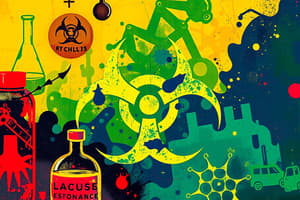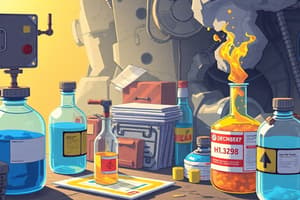Podcast
Questions and Answers
What happens to aluminium in a redox reaction?
What happens to aluminium in a redox reaction?
- It is reduced.
- It loses electrons. (correct)
- It gains electrons.
- It remains unchanged.
In the displacement reaction Cu (s) + 2Ag+(aq) → Cu2+ (aq) + 2Ag (s), what is the role of silver ions?
In the displacement reaction Cu (s) + 2Ag+(aq) → Cu2+ (aq) + 2Ag (s), what is the role of silver ions?
- They act as catalysts.
- They remain neutral.
- They are oxidised.
- They are reduced. (correct)
In the combustion of methane, which component is oxidised?
In the combustion of methane, which component is oxidised?
- Water (H2O)
- Carbon dioxide (CO2)
- Methane (CH4) (correct)
- Oxygen (O2)
What is the correct overall equation for the reaction of magnesium with oxygen?
What is the correct overall equation for the reaction of magnesium with oxygen?
What does it mean when oxygen is said to be reduced in a reaction?
What does it mean when oxygen is said to be reduced in a reaction?
What is the purpose of a Material Safety Data Sheet (MSDS)?
What is the purpose of a Material Safety Data Sheet (MSDS)?
What distinguishes hazardous substances from dangerous goods?
What distinguishes hazardous substances from dangerous goods?
What should a risk assessment include?
What should a risk assessment include?
Why must dangerous goods be labeled appropriately?
Why must dangerous goods be labeled appropriately?
Which of the following best describes a risk assessment?
Which of the following best describes a risk assessment?
What should be present on the labels of hazardous substances?
What should be present on the labels of hazardous substances?
Which of the following could be part of protective measures in a risk assessment?
Which of the following could be part of protective measures in a risk assessment?
What must all chemical suppliers provide according to safety regulations?
What must all chemical suppliers provide according to safety regulations?
How does increasing the temperature affect the rate of chemical reactions?
How does increasing the temperature affect the rate of chemical reactions?
What role do catalysts play in chemical reactions?
What role do catalysts play in chemical reactions?
Which of the following conditions would slow down a chemical reaction?
Which of the following conditions would slow down a chemical reaction?
Why do cold conditions result in a slow reaction rate?
Why do cold conditions result in a slow reaction rate?
What is the effect of increasing the surface area of solid reactants on a reaction?
What is the effect of increasing the surface area of solid reactants on a reaction?
If two reactants are present in low concentrations, what is likely to happen?
If two reactants are present in low concentrations, what is likely to happen?
What is an indirect result of using a catalyst in a chemical reaction?
What is an indirect result of using a catalyst in a chemical reaction?
In which scenario would the likelihood of particle collisions be minimized?
In which scenario would the likelihood of particle collisions be minimized?
What is the main role of catalysts in chemical reactions?
What is the main role of catalysts in chemical reactions?
Why are powdered or sponge-like solid catalysts considered more effective?
Why are powdered or sponge-like solid catalysts considered more effective?
What aspect of a catalyst is primarily useful in catalyzed reactions?
What aspect of a catalyst is primarily useful in catalyzed reactions?
Biological catalysts in the human body are known as what?
Biological catalysts in the human body are known as what?
What factor is NOT mentioned as affecting the rates of reaction?
What factor is NOT mentioned as affecting the rates of reaction?
What determines the effectiveness of a catalyst in a chemical reaction?
What determines the effectiveness of a catalyst in a chemical reaction?
Which type of catalyst is most likely to provide a large surface area for reactions?
Which type of catalyst is most likely to provide a large surface area for reactions?
In catalyzed reactions, catalysts appear in which form?
In catalyzed reactions, catalysts appear in which form?
What is the main purpose of balancing a chemical equation?
What is the main purpose of balancing a chemical equation?
Which type of chemical reaction involves the transfer of electrons?
Which type of chemical reaction involves the transfer of electrons?
What characteristic differentiates a precipitation reaction from other types of chemical reactions?
What characteristic differentiates a precipitation reaction from other types of chemical reactions?
How does surface area affect the rate of a chemical reaction?
How does surface area affect the rate of a chemical reaction?
What role do catalysts play in chemical reactions?
What role do catalysts play in chemical reactions?
Which of the following is an example of a combustion reaction?
Which of the following is an example of a combustion reaction?
What is the first step in balancing the chemical equation for the reaction of carbon monoxide with oxygen?
What is the first step in balancing the chemical equation for the reaction of carbon monoxide with oxygen?
Which of the following statements is true regarding oxidation and reduction in redox reactions?
Which of the following statements is true regarding oxidation and reduction in redox reactions?
What happens during a decomposition reaction?
What happens during a decomposition reaction?
What does the law of conservation of mass state in the context of chemical reactions?
What does the law of conservation of mass state in the context of chemical reactions?
Flashcards are hidden until you start studying
Study Notes
Dangerous Goods and Hazardous Substances
- Dangerous goods pose risks to people, property, or the environment and are labeled with specific signs.
- Hazardous substances affect human health and are marked with signal words or 'Hazardous' in red on their labels.
- Understanding the risks associated with classes and subclasses of dangerous goods is essential for safety.
Material Safety Data Sheet (MSDS) and Risk Assessment
- MSDS must be provided by all chemical suppliers for their products to inform users of associated risks.
- A risk assessment summarizes the experiment, identifies risks and safety precautions, and details protective measures against hazardous substances.
- Essential components of a risk assessment include a summary, risk list, protective measures, and first aid information.
Redox Reactions
- Redox reactions involve the transfer of electrons: oxidation (loss of electrons) and reduction (gain of electrons).
- Example: 2Al3+ + 3O2- → Al2O3 (Aluminum is oxidized and oxygen is reduced).
- Displacement example: Cu (s) + 2Ag+ (aq) → Cu2+ (aq) + 2Ag (s) illustrates oxidation and reduction.
Chemical Reactions Overview
- Types of chemical reactions include precipitation, corrosion, displacement, combustion, decomposition, combination, and neutralization.
- Combustion of methane: CH4 (g) + 2O2 (g) → CO2 (g) + 2H2O (g) highlights oxidation of fuel and reduction of oxygen.
- Combination reactions example: 2Mg (s) + O2 (g) → 2MgO (s) shows magnesium oxidizing to form magnesium oxide.
Factors Affecting Reaction Rates
- Temperature: Increasing temperature speeds up particle movement, improving collision rates.
- Surface area: Larger surface areas allow for more frequent collisions during reactions.
- Concentration: Higher concentrations increase the likelihood of particle interactions.
Catalysts and Their Role
- Catalysts accelerate reactions without being consumed, using their surface to facilitate successful collisions.
- Both powdered and sponge-like solid catalysts are effective due to their large surface areas.
- Enzymes serve as biological catalysts, playing crucial roles in biochemical reactions within the body.
Redox Reactions Recap
- Key concepts include understanding the difference between oxidation and reduction, accompanied by examples.
- Familiarity with various redox reactions and their applications in real-world processes is essential.
Laboratory Safety and Chemical Handling
- Understanding the need for safety and the dangers of substances classified as dangerous goods is critical for laboratory work.
- Essential safe practices involve recognizing MSDS and carrying out proper risk assessments before conducting experiments.
Practice Chemical Equations
- Balancing chemical equations involves converting word equations into formulae and ensuring equal numbers of atoms on both sides.
- Example process: From CO + O2 → CO2 to balancing with coefficients: 2CO + O2 → 2CO2.
Revision and Exercises
- Important exercises include reviewing rates of reaction, factors affecting reactions, and the role of various catalysts.
- Engage in worksheet activities and pre-tests to reinforce understanding of chemical reactions and their characteristics.
Studying That Suits You
Use AI to generate personalized quizzes and flashcards to suit your learning preferences.




